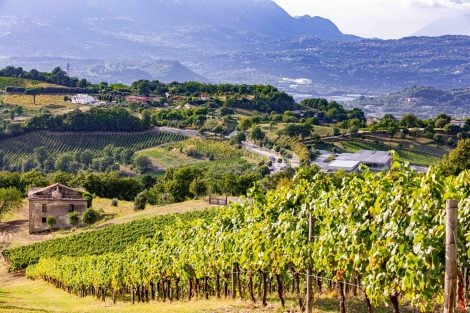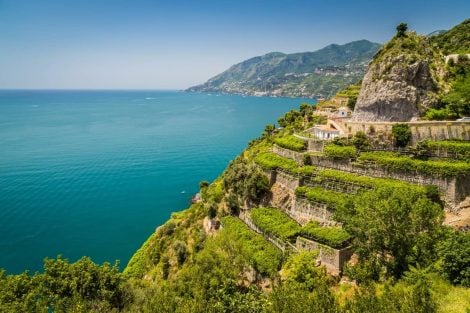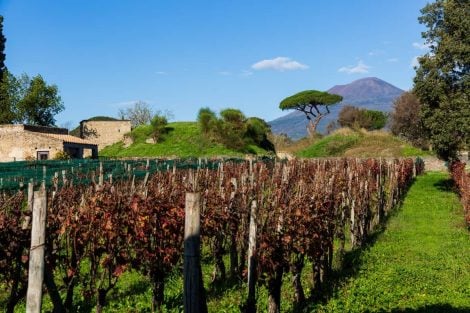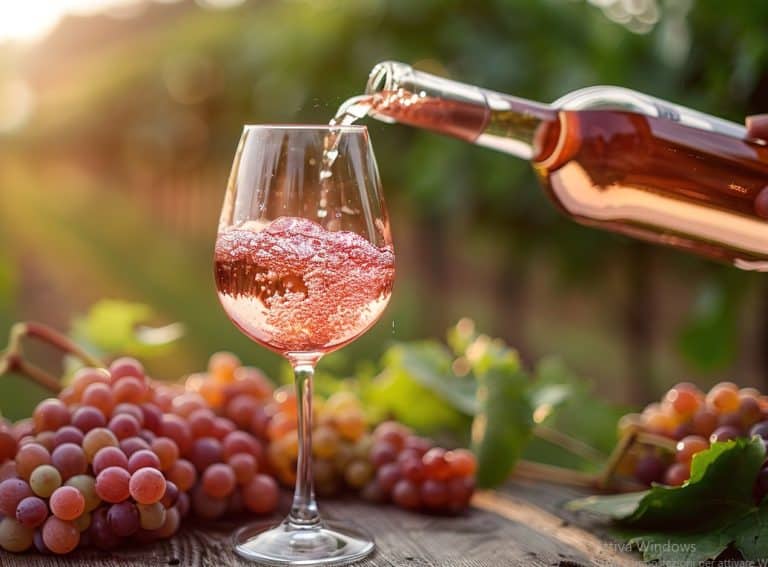Starting with the clichéd “Campania, lights and shadows,” to describe the situation we found in the region this year after our tastings would be truly unfair. It’s true that we found some flaws, but it’s equally true that the highlights shine very brightly.
Here, we focus on the rosé wines of Campania, primarily made from Aglianico and Piedirosso, cultivated in Irpinia and the Amalfi Coast, where stunning whites can also be found, and on the slopes of Vesuvius, a district that we are sure will come under the spotlight in the near future.

Campanaro, Vigneto Pietrascilonga, Feudi di San Gregorio
Irpinia is located in the continental heart of the region; it’s a zone of hills rising towards the Campanian Apennines, often producing whites with "mountain" aromatic and gustatory profiles: elegance, minerality, and fresh acidity. Typical grape varieties include Aglianico, Coda di Volpe, Falanghina, Fiano, Greco, Piedirosso, and Sciascinoso.
The DOC Costa d'Amalfi includes the three authorized subzones of Ravello, Furore, and Tramonti, areas long devoted to agriculture, with varying exposures and microclimates. The municipalities within the DOC are thirteen, all in the province of Salerno. The DOC provides for White, Rosato, and Red types, the latter two made from Piedirosso and/or Sciascinoso (also known as Olivella) and at least 60% Aglianico, with other authorized varieties up to 40%.

The slopes of Vesuvius yield exceptional grapes. The DOC includes White, Rosato, and Red types. Rosato and Red are produced with Piedirosso (locally called Palombina), Sciascinoso, and Aglianico. The maximum yield for wine grapes is 70%, but with a yield of 65% and an alcohol content of 12°, both White and Rosato and Red can be called "Lacryma Christi del Vesuvio," two excellent expressions of which can be found in the following list.

Returning to general considerations about Campania wine, other positive notes come from territories increasingly in the limelight: if the Campi Flegrei are a bet already won, our next stakes are on the sunny Mediterranean nature of Cilento. Sannio is also thriving: relying on Falanghina as usual to stand out regionally and nationally, but we’ve also tasted increasingly focused Aglianico, emphasizing juicy, ripe, and fruity parts rather than tannic components. Otherwise, it was the usual fun tasting, discovering many zones, many small producers eager to emerge, and many large companies consolidating their guiding role in a crowded and competitive wine landscape.
As we have already pointed out regarding the best rosé wines of Puglia, Sicily, and Cerasuolo d'Abruzzo, rosé is not a product category but a different interpretation of a territory. We believe that in recent years, the growth of rosé wines has been significant. Finally, we find rosés made with the best available grapes, with many wineries deciding to strongly focus on this type, offering important and well-structured ranges of rosés. The market is responding enthusiastically, in Italy and abroad.
The best Rosés from Campania from Aglianico and Piedirosso
The grape varieties most present in the list of labels we propose are Aglianico and Piedirosso, which increasingly more producers are investing in to obtain high-quality wines even in the rosé type. They come from Irpinia, the slopes of Vesuvius, and the Amalfi Coast, among DOC and IGT wines.
Era 79 Rosato by Tenuta Augustea (Piedirosso 90%, Aglianico 10%)**: Spicy, mineral, and sulphurous, it is fresh and tense, lively and savory, with great drinkability. This small winery in Somma Vesuviana has achieved excellent results over the years. Now in its fourth generation, the company has seven hectares of vineyards, mostly on own-rooted vines.
Munazei Rosato 2022 by Casa Setaro (Piedirosso 100%): Offers aromas of flower meadows, field herbs, rose, and pomegranate, blending before diving into a fresh and agile sip that ends with a hint of pink grapefruit. Located in the village of Trecase, on the slopes of Vesuvius, within the National Park, the vineyards are up to 350 meters high on volcanic soils.
Pompeii Rosato 2022 by Bosco de'Medici (Piedirosso 100%): One of the wines presented this year by the winery. Near the archaeological excavations of Pompeii, the Medici, in the 16th century, had estates close to the current vineyards of the Paolomba and Monaco families, who named the winery after them. Cultivated grapes include Piedirosso, Aglianico, and Falanghina, with other vineyard bodies in the municipalities of Terzigno and Boscoreale.
Costa d'Amalfi Rosato Terre Saracene 2022 by Ettore Sammarco (Piedirosso 70%, Aglianico 30%): One of the wines presented this year by Ravello’s best-known winery, named after its founder, Ettore Sammarco. Today, the company relies on a trusted group of contributors: Bartolo, Ettore's son, works to enhance this heritage by creating Mediterranean-style wines from exclusively indigenous grapes.
Rosato 2022 by Fonzone (Aglianico 100%): One of the best in the region in this category: rose petals, strawberry, very tasty and pleasant in the mouth. Lorenzo Fonzone Caccese, a surgeon by profession, ventured into the wine world in 2005. In just under twenty years, the company has made a name for itself in the Irpinian landscape: the grapes from the 20 hectares of property are processed in a modern, underground cellar, perfectly integrated with the territory.
Visione Rosato 2022 by Feudi di San Gregorio (Aglianico 100%): One of the wines presented this year by the company led by Antonio Capaldo with the support of Pierpaolo Sirch, featuring a remarkable production encompassing all major regional denominations. There is an excellent range of options in the outstanding lineup presented this year.
Regina Sofia by Mustilli (Aglianico 100%): A frizzante on the lees, tasty, iodized on the nose, nuanced with currant and pomegranate, with a tense, lively, pleasant, and "thirst-quenching" sip. The company, currently run by Paola and Anna Chiara, with the technical support of Fortunato Sebastiano, year after year offers labels that tell the story of the Sant'Agata dei Goti territory.
Rose Season by I Favati (Aglianico 100%): A fragrant rosé with floral hints of rose and wisteria, intriguing raspberry notes, agile and elegant. The company's history is relatively recent (starting in the early 2000s), yet when Favati is mentioned, it's as a "classic." Especially notable is the Pietramara, a Fiano di Avellino from the namesake vineyard in Atripalda, a true flagship. But man does not live by Fiano alone.
Primula Rosa by Cantine Barone (Aglianico 100%): A Mediterranean-style rosé, sunny and tasty. The winery was founded in 2004 by Giuseppe Di Fiore, Francesco Barone, and Emanuele Perrella, who renovated a social winery to start this business, which has grown significantly over the years. The vineyards, mainly Fiano and Aglianico, are in the Cilento National Park. In the cellar, Vincenzo Mercurio transforms the grapes from about twelve hectares into a range of increasingly focused Mediterranean wines.
Vita Nuova Rosato by Fulvio Cautiero and Imma Cropano (Aglianico 100%): Reminiscent of watermelon and red currant, spicy, structured, savory, and very tasty. Fulvio Cautiero and Imma Cropano started recovering old vineyards in the Taburno Regional Park in 2002. Here they produce the typical wines of Sannio, with a range of great character.


 US tariffs: here are the Italian wines most at risk, from Pinot Grigio to Chianti Classico
US tariffs: here are the Italian wines most at risk, from Pinot Grigio to Chianti Classico "With U.S. tariffs, buffalo mozzarella will cost almost double. We're ruined." The outburst of an Italian chef in Miami
"With U.S. tariffs, buffalo mozzarella will cost almost double. We're ruined." The outburst of an Italian chef in Miami "With US tariffs, extremely high risk for Italian wine: strike deals with buyers immediately to absorb extra costs." UIV’s proposal
"With US tariffs, extremely high risk for Italian wine: strike deals with buyers immediately to absorb extra costs." UIV’s proposal Meloni: "Tariffs? If necessary, there will be consequences. Heavy impact on agri-food sector"
Meloni: "Tariffs? If necessary, there will be consequences. Heavy impact on agri-food sector" The Government honours the greats of Italian cuisine, from Bottura to Pepe. Massari: "Thank you, Meloni, the only one who listened to us"
The Government honours the greats of Italian cuisine, from Bottura to Pepe. Massari: "Thank you, Meloni, the only one who listened to us"






